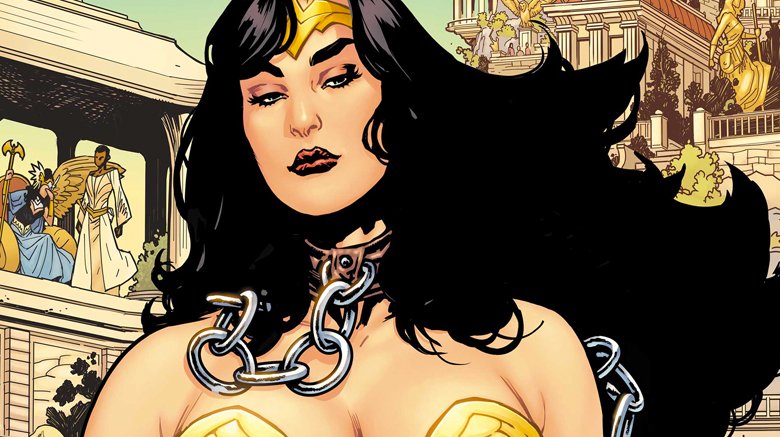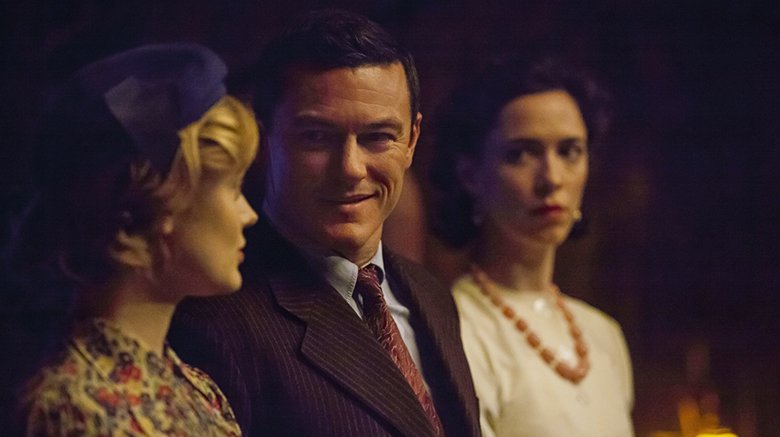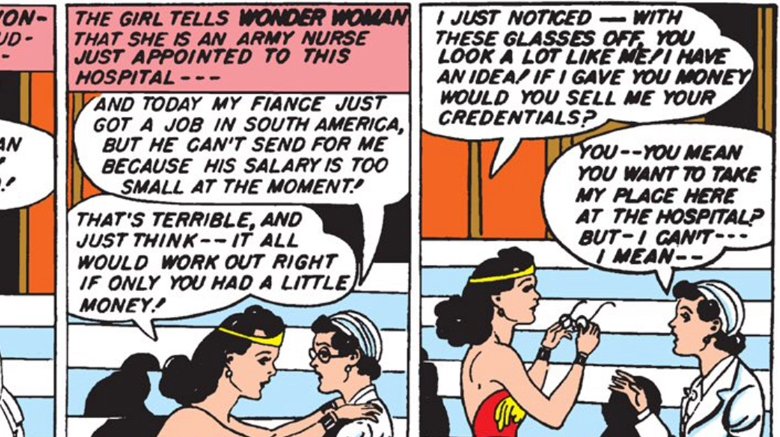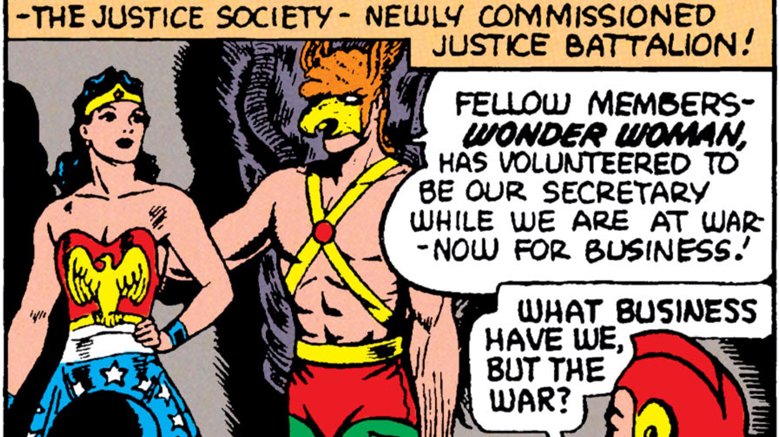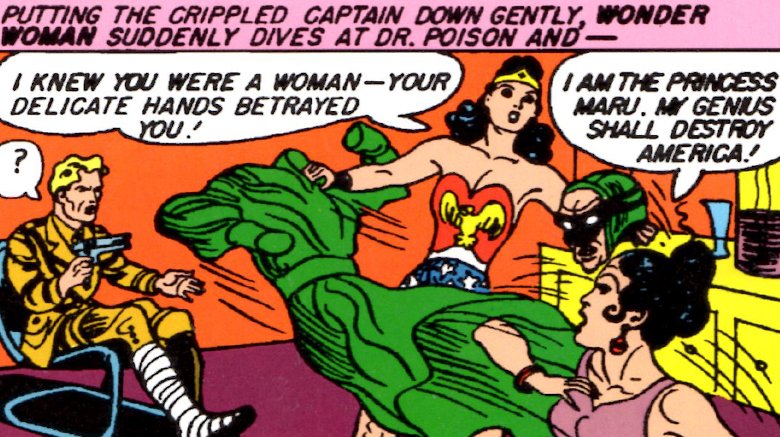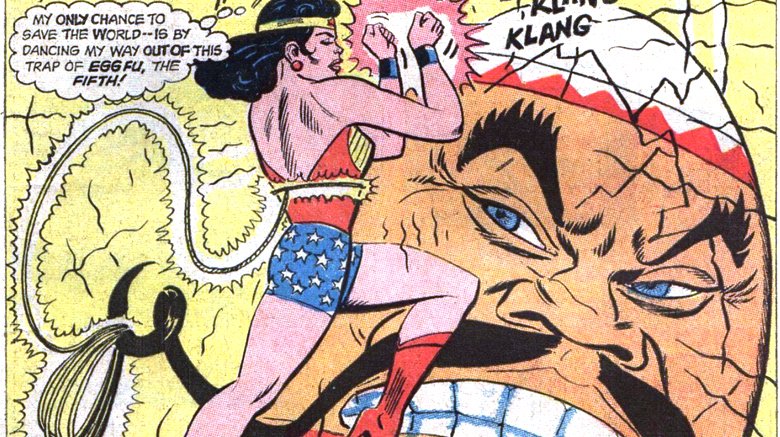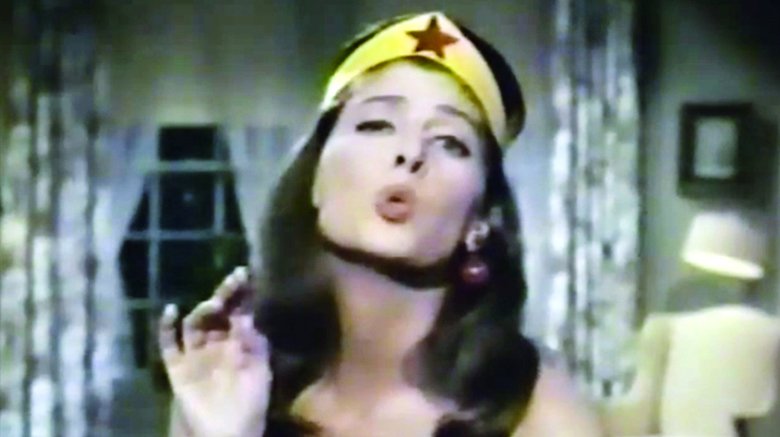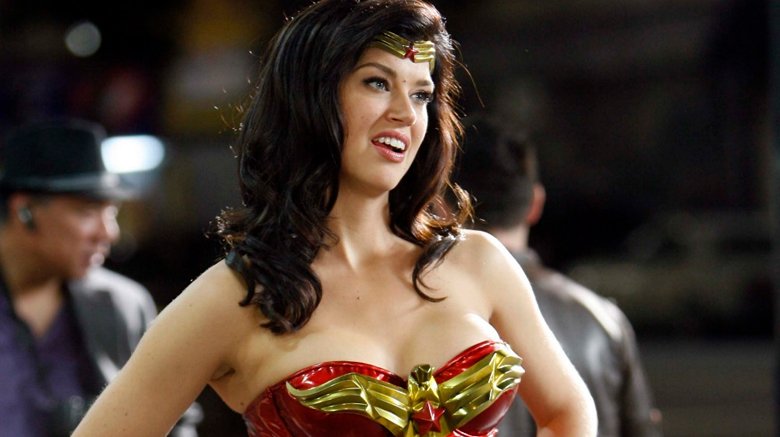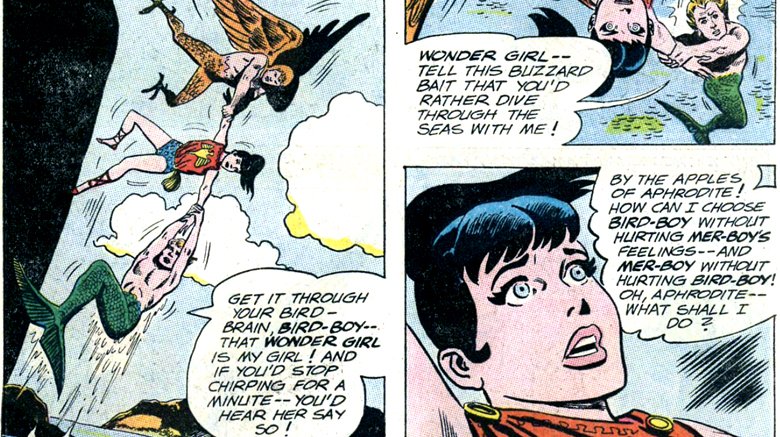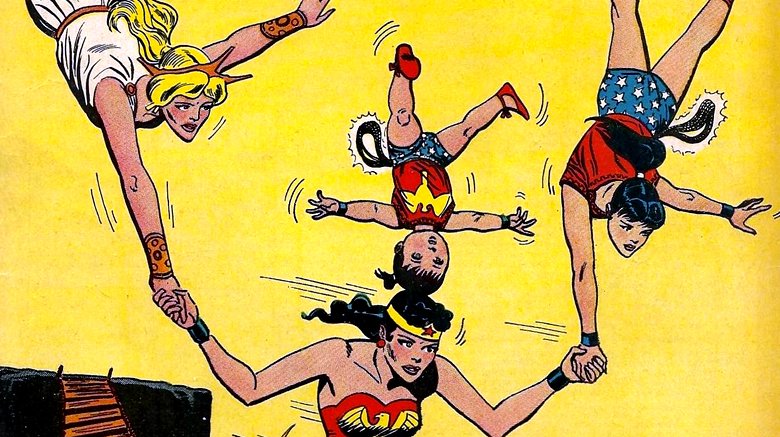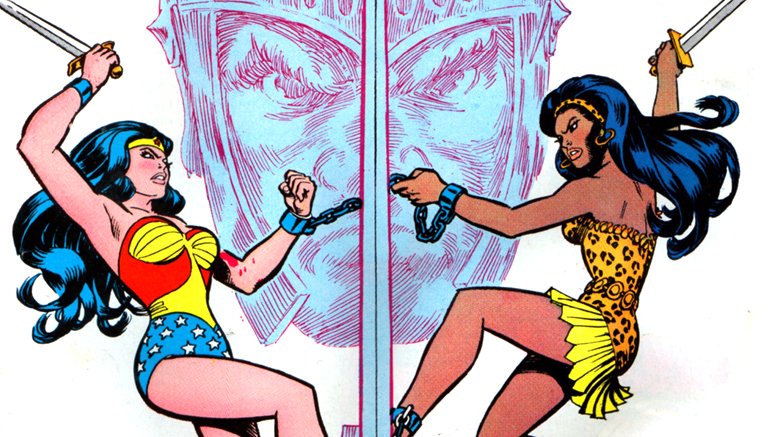Things DC Wants You To Forget About Wonder Woman
If you haven't heard, Wonder Woman is a big deal these days. Her solo film debut was a gigantic hit, and DC Comics is making a huge number of her classic stories available in print collections and digitally. However, there are some aspects of Wonder Woman and her history that DC is definitely not in a hurry to acknowledge. Whether outdated or just a little too weird for the mainstream (something Wonder Woman, like her creator, has often been), these elements sometimes get swept under the proverbial rug. Below are ten things about Wonder Woman that DC Comics would rather you not remember.
Her creator had unusual beliefs and two wives
Wonder Woman's co-creator (with artist Harry G. Peter) was William Moulton Marston, a psychologist who was also responsible for the principles behind the polygraph lie detector test. His wife, Elizabeth Holloway Marston, is said to be responsible for giving him the idea of a female superhero—and that superhero, Wonder Woman, was visually inspired in part by their girlfriend Olive Byrne, and the metal cuff bracelets she liked to wear. Yes, Olive was their girlfriend in the romantic sense. In fact, she was their live-in partner, their third spouse. The trio were what would have been considered at the time radical feminists, believing that women not only deserved freedom to pursue their own lives and pleasure, but were better suited to run the world. They attended meetings at the home of Carolyn Keatley, who led what some might uncharitably call a feminist sex cult. In time, Marston fathered children with both Holloway and Byrne, and when he died in the 1950s, the two mothers continued to live together and raise those children as a family.
In today's complicated world, none of this needs to be shameful. But for a media company that wants all kinds of parents to feel comfortable buying products featuring Wonder Woman for their kids, it's all a bit much. Especially because Marston's beliefs, including an interest in bondage and "loving submission," constantly find their way into the Wonder Woman comics he wrote. If you didn't know the real history, you might not notice how kinky those early comics often are—but once you do, you can't help but see it. It's all outlined in Professor Marston & the Wonder Women, a 2017 biopic directed by Angela Robinson that attempts to tell the whole story of Marston and Holloway and Byrne.
One of the first things she did was commit identity fraud
Most people know that Wonder Woman's secret identity, when she bothers to have one, is Diana Prince. Since her real identity is Princess Diana, you might assume she got her American alias just by flipping that around. But in Sensation Comics #1, when Wonder Woman first arrives in the U.S., she goes about it differently.
Arriving at a military hospital to check up on the injured Steve Trevor, Diana comes upon a weeping nurse who happens to look just like her. It turns out the nurse is actually named Diana Prince, and she's crying because her fiancé has found work in South America and she has no money to join him. Wonder Woman has just earned a pile of cash by demonstrating her Amazon abilities onstage, so she offers the other Diana a deal: Diana Prince sells Princess Diana her credentials and leaves the country, and Wonder Woman goes to work.
It seems she was trained in nursing on Paradise Island, so this deception isn't a problem for her patients. However, she's also an undocumented immigrant who got a job with the military using somebody else's paperwork, which seems like something somebody somewhere might have a problem with.
She joined the Justice Society as their secretary
The Justice Society of America was the first superhero team in comics and the predecessor to the Justice League. Led by Hawkman, it included illustrious DC heroes like Green Lantern, the Flash, and Starman. Unsurprisingly, the team was entirely male to start with, although the original Red Tornado, a middle-aged housewife who became a gender-ambiguous comedy hero, made an appearance at their first meeting in All-Star Comics #3. But in All-Star #12, they welcomed their newest ally, Wonder Woman. As their secretary.
World War II was in full swing, and the Society had just been commissioned by FDR to become an official part of the war effort as the Justice Battalion, so it made sense that they might need someone to take minutes at their meetings. It makes no sense, however, that the job should go to a trained warrior who's probably more powerful than anyone on the team except the omnipotent Spectre and the sorcerous Dr. Fate. But this comic was written by Gardner Fox, who lacked the feminist background of William Moulton Marston, so in 1942, this probably seemed like the obvious way to bring in a female member.
Fortunately, the secretary aspect of her membership was soon dropped as she kept getting involved in their adventures. And by All-Star Comics #41, when the JSA finally got a second female member in Black Canary, this particular silliness was no longer a concern.
Many of her original supervillains dressed in drag
Wonder Woman's first supervillain, debuting in Sensation Comics #2, was Doctor Poison, who you probably know from the Wonder Woman movie. Unlike the movie version, this Doctor Poison was introduced as a man. Only at the end of the story does Wonder Woman pull off his mask, Scooby-Doo style, to reveal the face of Princess Maru. Not long after, in Sensation Comics #9, Wonder Woman encounters the beautiful female spy known as Agent X, who is in turn revealed to be a man. Throughout the Golden Age, this was a common trope in her comics, with other villains like Hypnota and the Blue Snowman also crossing gender lines with their secret identities. It's all kind of fun, and certainly not really a big deal, but much like the bondage and polyamory aspects of her creation, it's going to bother some people more than others—and it's largely been abandoned in retellings of those stories.
One of her supervillains was a racist egg
Wonder Woman's most embarrassing villain of all debuted in Wonder Woman Vol. 1 #157. In 1965, evil Chinese communist agents were not uncommon as bad guys, but none of them were quite like Egg Fu—literally a gigantic egg with a racist caricature for a face and a Charlie Chan-esque stereotyped accent. Lacking limbs, he attacked people with his mustache, and was also presented as a strategic and scientific mastermind. Weirdly, he managed to kill both Wonder Woman and Steve Trevor in that first appearance, but Queen Hippolyta brought them back to life with Amazon technology. It's good to know that option is always there when thing go badly.
As for Egg Fu, he went the Humpty Dumpty route, but has been brought back again and again over the years, most recently in Harley Quinn Vol. 3. Recent creators have made an effort to make the character less racist, but whether he's worth that effort is the real question. At the very least, we can be confident he won't be in a Wonder Woman movie anytime soon.
She starred in an embarrassing TV pilot in 1967
With the popularity of Batman in the 1960s, producer William Dozier started looking for other DC superheroes to bring to television, and Wonder Woman seemed like an obvious choice. Dozier brought on writer Stanley Ralph Ross and director Leslie H. Martinson, both of whom worked on Batman, to create a five-minute Wonder Woman pilot starring Ellie Wood Walker in the title role. Despite featuring Dozier's memorable narration, the short completely lacks the enjoyably campy tone of Batman, aiming instead for broad comedy. Diana Prince is portrayed as a mousey klutz living with her mother, who is definitely not the Queen of the Amazons. Much of the pilot consists of Walker posing in front of a mirror, in which she sees herself as more beautiful than she's actually meant to be. The whole thing feels sexist and unappealing, and Wonder Woman fans should give thanks that only five minutes of it were ever made.
Then she starred in another embarrassing TV pilot in 2011
The second effort to bring Wonder Woman to television was successful, although it took two pilots—one starring blonde tennis player Cathy Lee Crosby and then a second with Lynda Carter, who would star in the series. But there was a third effort much later, with a pilot produced in 2011. It's nowhere near as bad as the 1967 version, but it's certainly not good. This Wonder Woman was produced and written by David E. Kelley, of Ally McBeal fame, who certainly left his mark on it. Adrianne Palicki played the title role, with Elizabeth Hurley as the villainous Veronica Cale.
In this incarnation, Wonder Woman publicly goes by the name Diana Themyscira, and runs a corporation to support her costumed crimefighting. She also has a secret identity as Diana Prince, which she uses to avoid the public eye. Much of the pilot revolves around her efforts to balance her life as a corporate Wonder Woman with her desire to be a normal woman, while also thwarting the evil Veronica Cale, who's selling deadly drugs that give people superpowers. Wonder Woman uses her lasso in fight scenes, but at one point breaks a man's arm to get information from him, implying that her "Lasso of Truth" doesn't serve its literal function. There's no mention of Amazons, although that may well have been revealed if the pilot had gone to series.
Palicki has a pretty good look for Wonder Woman, and acts the role as best she can given the script. However, the costume does her no favors, with the elements that should be metal looking unmistakably like plastic, to give the whole thing the air of a Halloween party. Palicki did later get to prove herself as a superhero, playing Bobbi Morse, a.k.a. Mockingbird, on Marvel's Agents of S.H.I.E.L.D.
Her first two love interests were a fish and a bird
Wonder Woman Vol. 1 #107 established that Princess Diana had already worn a version of her costume as a teenager, having adventures on and around Paradise Island as Wonder Girl. The Wonder Girl stories proved popular and became a regular feature of Wonder Woman comics in the early 1960s. Eventually, writer Robert Kanigher decided that Wonder Girl needed a love interest; however, it had long been established that Steve Trevor, who she met as an adult, was the first human male she'd ever seen. So in Wonder Woman Vol. 1 #124, Kanigher and artist Ross Andru introduced Mer-Boy, a fish-tailed lad from the sea for Wonder Girl to have chaste adventures with. But teen romance tropes require a love triangle, so in Wonder Woman Vol. 1 #144, Kanigher and Andru added Bird Boy to the mix. A teen from a race of winged bird-people, Bird Boy competed with the aquatic Mer-Boy for the attentions of land-dwelling Wonder Girl. It was all meant to be innocent and fairytale-esque, but the fact that neither of Diana's first two boyfriends were human makes the whole thing feel silly...and maybe a little creepy.
Modern stories, including Wonder Woman: Earth One by Grant Morrison and Yanick Paquette, simplified matters by saying that before Steve Trevor entered the picture, young Princess Diana had relationships with other girls. But in the 1960s that option just wasn't on the table, so fish and birds were the only way to go.
She spent the '60s hanging out with two younger versions of herself
After the success of the Wonder Girl stories, there were also stories of Diana as a toddler, known as Wonder Tot (yes, really). At first, as you'd expect, adult Wonder Woman, teen Wonder Girl, and baby Wonder Tot all appeared in different stories within the Wonder Woman comic. Obviously Diana's mother Queen Hippolyta appeared alongside all three (and since she's immortal, she always looked exactly the same).
However, in Wonder Woman Vol. 1 #124, things got complicated. In that issue, Wonder Woman teams up with Wonder Girl and Wonder Tot, as well as Queen Hippolyta. The story is presented as a flight of fancy that Wonder Woman and Hippolyta create using spliced-together film footage (it's good to know there are home movies on Paradise Island). However, the story was successful enough that these team-ups soon became the norm. The Wonder Woman Family consisted of one Hippolyta and three Dianas, and they regularly had adventures together. Wonder Woman in the early-to-mid 1960s wasn't concerned with continuity or realism, just fun stories for kids.
The person most confused by all of this might have been Bob Haney, who included Wonder Girl in the Teen Titans, a collection of superhero sidekicks, when he introduced them in Brave and the Bold #60. He'd seen Wonder Girl hanging out with Wonder Woman, and understandably assumed they were two completely different people. The Wonder Girl of the Teen Titans was later established as Donna Troy, and as such is a rare character to be created by accident.
In the '70s, she had a black sister named Nubia
In 1973, superhero comics were making an effort to introduce more black characters, but with most of the books written and drawn by white men, it didn't always go so well. For example, in Wonder Woman Vol. 1 #204, Princess Diana meets another warrior who claims the title of Wonder Woman—a black woman named Nubia who rules a floating island otherwise populated entirely by black men. To Diana's surprise, Hippolyta reveals that Nubia is her sister. The Amazon Queen explains that she actually sculpted not one, but two baby girls—one from dark clay, and one from light clay—however, the dark-skinned child was stolen by the War God Mars to be used against the Amazons. Diana frees Nubia from the influence of Mars and they become friends as well as sisters. However, someone at DC apparently decided this wasn't a great idea, and Nubia quickly disappeared from the book.
It's kind of a shame, in a way. Wonder Woman having a black sister, or at least a close Amazon ally who's black, has plenty of potential. However, the name "Nubia" is much too on-the-nose, and the whole "light clay/dark clay" aspect is a pretty cringeworthy way of dealing with race.
This is basically how it works with most of the embarrassing aspects of Wonder Woman's past. There's often something worthwhile at the center, but everything around it gets kind of weird, because for much of her existence, Wonder Woman's comics have been pretty weird. But here and now, with all of her history to draw from, it's nice to imagine that all of these concepts can be reconciled to bring out the best in them. Except probably for Egg Fu—they really should just leave him alone.
